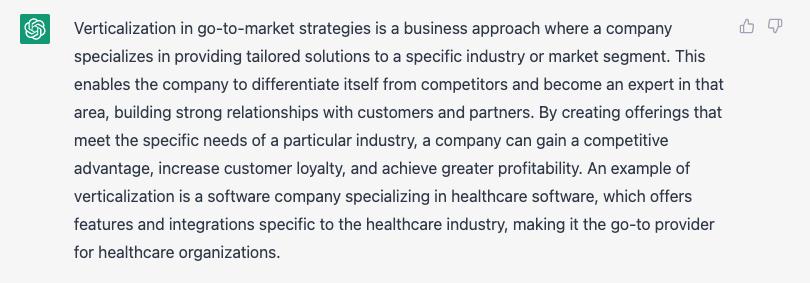For B2B tech firms with high Average Contract Values (ACVs) and long sales cycles, an efficient...
Mastering Vertical GTM Strategy: Real-World Examples from Emerging Tech Companies and Actionable Steps for B2B Success
Verticalizing your go-to-market (GTM) strategy is often a crucial step for targeting specific industries effectively and accelerating growth. In this blog post, we'll explore actionable pointers and real-world examples to help you verticalize your GTM strategy and boost your B2B success.
Identifying and Prioritizing Key Verticals
- Conduct market research
-
-
- Assess market trends and customer needs, speaking with actual customers and prospects.
- Evaluate how your solution addresses their unique challenges.
Example: Flatiron Health recognized the potential of the oncology sector and developed a cloud-based platform to streamline the workflow for cancer care providers.
-
- Establish vertical customer advisory boards
-
-
- Gather industry-specific insights to guide your strategy.
- Focus your efforts by prioritizing key verticals.
Example: Slack's customer advisory board includes companies from diverse industries, offering valuable insights for vertical-specific strategies.
-
Crafting Targeted Messaging and Content
- Develop vertical-specific messaging
-
-
- Create industry-specific case studies, thought leadership pieces, and landing pages.
- Tailor your value proposition and references for each vertical.
Example: Canva has tailored its design platform for specific industries, such as Canva for Nonprofits and Canva for Education.
-
- Leverage customer references and testimonials
-
-
- Build trust with case studies, quotes, and content from customers in the same industry.
- Use recognizable customer references to open up new segments.
Example: Notion showcases customer success stories from various industries, like startups, marketing agencies, and educational institutions.
-
Engaging Vertical Influencers and Creating Assets
- Organize vertical-specific events
-
-
- Partner with known vertical influencers for virtual peer roundtables.
- Offer exclusive resources and experiences for target industries.
Example: Segment hosts industry-specific webinars and roundtables focusing on sectors like eCommerce, SaaS, and fintech.
-
Building Dedicated Teams for Verticals
- Assign verticals to specialized team members
-
-
- Enable your SDR or sales teams to focus on specific industries.
- Help them understand the unique needs and challenges of each vertical, and speak their language.
Example: Asana, a work management platform, has dedicated industry teams focused on sectors like marketing, product development, and sales.
-
Using Data and Analytics to Measure Success
- Monitor and adjust your vertical strategy
-
-
- Track metrics like win rates, deal size, customer retention, and engagement for each vertical.
- Use data to refine your approach and optimize results.
Example:Revolut evaluates its vertical strategy performance, leading to the development of specialized financial solutions like Revolut for Business and Revolut for Freelancers.
-
Verticalizing your GTM strategy can be instrumental to unlocking success in the B2B landscape. Share your experiences, successes, and challenges with verticalization in the comments below. Let's learn from one another and propel our businesses to new heights!




